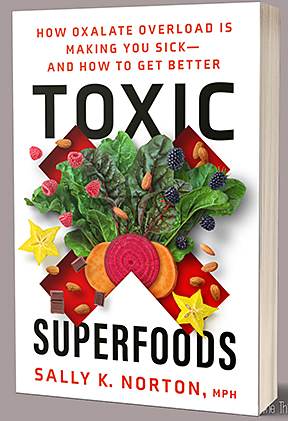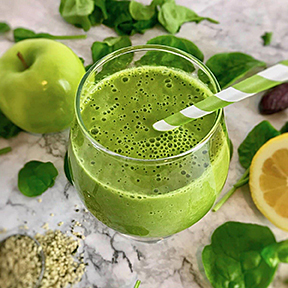Spinach Smoothies Surprise
I have written before on the dangers of seed oils. These machined, ultra processed inflammatory oils like corn oil, canola oil, grape seed oil etc. are probably still in your cabinet. Today I write about a danger in your fridge. High oxalate foods.  Veggies you thought were super healthy can in fact be supertoxic and may be accounting for all those odd symptoms you have. Oxalates are natural compounds like lectins and nightshade that act to protect plants. Once ingested they form tiny and not so tiny crystals all over the body. Crystals might be nice on a necklace but they are not so nice in your kidneys and oxalates are a major component of many kidney stones. The bad effects from these substances have been known in the medical literature for over 150 years. The signs and symptoms of hyperoxalosis are protean but include irritable bowel syndrome, reflux, hypothyroidism, diabetes, allergies, mast cell activation, raynaud’s syndrome, headaches, arthritis, gout, tinnitus, genital pain, and kidney stones just to name a few. Different people absorb the oxalates at different rates and the manifestation of hyper oxalate states can obviously be very different in each person.
Veggies you thought were super healthy can in fact be supertoxic and may be accounting for all those odd symptoms you have. Oxalates are natural compounds like lectins and nightshade that act to protect plants. Once ingested they form tiny and not so tiny crystals all over the body. Crystals might be nice on a necklace but they are not so nice in your kidneys and oxalates are a major component of many kidney stones. The bad effects from these substances have been known in the medical literature for over 150 years. The signs and symptoms of hyperoxalosis are protean but include irritable bowel syndrome, reflux, hypothyroidism, diabetes, allergies, mast cell activation, raynaud’s syndrome, headaches, arthritis, gout, tinnitus, genital pain, and kidney stones just to name a few. Different people absorb the oxalates at different rates and the manifestation of hyper oxalate states can obviously be very different in each person.
Especially at risk for overload are people with a diet low in calcium and other minerals including dairy-free and vegan diets. Frequent use of gut irritating foods including beans, bran, whole grains and quinoa. Also, a history of repeated use of antibiotic or antifungal medications and long-term use of nonsteroidal anti-inflammatory medications, obesity, diabetes, irritable bowel, bariatric surgery and poor kidney health all predispose to oxalate overdose.
As mentioned in her new book, Toxic Superfoods, by Sally K. Norton, most of the alternate milks are high in oxalates including almond milk, soy milk etc. Also, to my dismay, I found out from reading the book that using high doses of supplemental Vitamin C is a potential significant source of oxalate and high oxalate foods like spinach, rhubarb, buckwheat, tea, beet juice, sweet potatoes and beet greens are a major instigator of chronic inflammation. I may have to rethink my advice about vitamin C supplementation at least in people who don’t feel well.
Many of you who really don’t know much about oxalates will perhaps remember the cleaner Zud cleanser…it was a scrubbing powder used to clean pots and pans. This is oxalic acid and prolonged skin contact can cause serious damage.
Unfortunately, there is no clear set of symptoms that proves a person has oxalate excess and there is no particularly reliable urine or blood test.

There is a 24-hour urine collection you can do but it is only reliable if the results are high. Many people with clearcut hyperoxylate syndrome have short high spikes that produce the damage but the 24 hour collection is within the normal range. Therefore, since there is no reliable blood test or urine test, it’s up to the physician to make the diagnosis or to suggest the diagnosis based on the clinical complaints of the patient. Classic signs of oxalate overload include cloudy urine, crystals in the urine, recurrent yeast infections, episodic irritable bladder, recurrent kidney stones, periodic joint pain or weakness, unexplained digestive distress or abdominal pain, unexplained brain fog or mood problems, signs of vasospasm including Raynauds, unexplained pain such as burning mouth and tooth pain or burning in the genitalia. Also, slower and incomplete recovery from injury or surgery, low bone density or unexplained skin problems may be manifestations of oxalate excess.
Oxalates are generated in the body in small amounts by the usual metabolic processes but during times of metabolic stress, oxalate production increases. Sally K. Norton describes three key features that increase this stress. #1) is the use of the seed oils…canola oil, corn oil, cottonseed oil to name a few. #2) is excessive sugar and starch in the diet and #3) is excessive calories overall. Oxalates are produced by biochemical reactions in the body, so you generate about 12 mg a day of oxalates and then dietary oxalate sources make up the rest and if that total goes above 25 mg kidney damage is done.
 Sally K. Norton’s solution is based first of all on switching to low oxalate foods and navigating the flairs that happen as you mobilize the crystals. She then recommends a Five Point plan that includes #1) rest and Vitamin D, #2) mineral supplementation including calcium, potassium, magnesium, sulfur, and trace minerals #3) citrates, #4) B complex vitamins and not too much of the vitamin C and finally, #5) avoid too many probiotics, motrin type meds and antibiotics.
Sally K. Norton’s solution is based first of all on switching to low oxalate foods and navigating the flairs that happen as you mobilize the crystals. She then recommends a Five Point plan that includes #1) rest and Vitamin D, #2) mineral supplementation including calcium, potassium, magnesium, sulfur, and trace minerals #3) citrates, #4) B complex vitamins and not too much of the vitamin C and finally, #5) avoid too many probiotics, motrin type meds and antibiotics.
So, if you feel great ignore me as always but if you don’t have the health you want why not go on a low oxalate diet for a month or two and see how you feel. It’s not a deprivation diet, it’s a substitution diet. You can reference Ms. Norton’s book or contact her on the internet for a consultation. If you go low oxalate you may at some point have your symptoms actually worsen…that’s actually a good sign that you are mobilizing the oxalates and the symptoms will resolve over time.
So, one more thing to worry about in your diet OR a possible answer to all your undiagnosed issues. The book Toxic Superfoods is an excellent reference for you. Until next month…get well and stay well.











